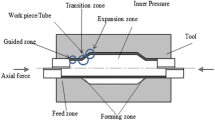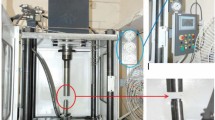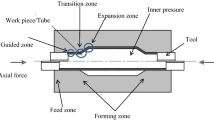Abstract
In this paper, the effect of different lubricants on coefficient of friction in tube hydroforming using mathematical model is presented. To determine the minimum coefficient of friction in tube hydroforming, a mathematical model is used based on tube upsetting method. The presented models uses the given geometrical parameters of the tube to estimate optimized inner pressure (pi) and optimized initial thickness of the tube (S0) obtained from the mathematical model. Using optimized inner pressure (pi) and optimized initial thickness of the tube (S0), minimum COF (µ) between tube and die interface is determined. Experiments are carried out on manufactured component metal expansion bellows using different geometrical parameters, materials SS304, SS316 and SS316L with lubricants Enklo68, Enklo47, Enklo32, Enklo100 and ethylene glycol. The influence of these lubricants on COF for each material is investigated.







Similar content being viewed by others
Abbreviations
- S 0 :
-
Initial wall thickness (mm)
- S1 :
-
Wall thickness at the side of movable punch (mm)
- S2 :
-
Wall thickness at the side of fixed punch (mm)
- da:
-
Initial outer diameter of the tube (mm)
- di:
-
Initial inner diameter of the tube (mm)
- di1:
-
Final inner diameter of the tube at the side of movable punch (mm)
- di2:
-
Final inner diameter of the tube at the side of fixed punch (mm)
- h0 :
-
Initial height of tube (mm)
- h:
-
Final height of tube after deformation (mm)
- C:
-
Strength coefficient
- n:
-
Strength hardening exponent
- pi:
-
Inner pressure of tube
- S0 :
-
Initial tube thickness
- µ:
-
Coefficient of friction
References
Koç M, Altan T (2001) An overall review of the tube hydroforming (THF) technology. J Mater Process Technol 108(3):384–393
Dohmann F, Bieling P (1991) Theoretical basis and applications of high pressure forming. Bleche Rohre Profile 38(5):379–385
Dohmann F, Hartl C (1994) Liquid bulge forming as a flexible production method. J Mater Process Technol 45(1–4):377–382
Dohmann F, Hartl C (1998) Hydroforming components for automotive applications. Fabricator, 30–38
Rudraksha SP, Gawande SH (2017) Optimization of process parameters to study the influence of the friction in tube hydroforming. J Bio Tribo Corros 3(4):56. https://doi.org/10.1007/s40735-017-9
Story JM, Jarvis GW, Murtha SJ (1993) Issues and trends in automotive aluminum sheet forming. SAE Publication Sp.- vol 944, pp 1–25
Rao KP, Wei JJ (2001) Performance of a new dry lubricant in the forming of aluminum alloys sheets. Wear 249:86–93
Erdemir A, Fenske GR (1998) Clean and cost-effective dry boundary lubricants for aluminum forming. SAE Special Publication, NO. SP-1350, pp 9–17
Simonetti C (2000) Why are you lubricating on-site, Fabricating Equipment News, October, pp 55–57
Kang BH, Lee MY, Shon SM, Moon YH (2007) Forming various shapes of tubular bellows using a single step hydroforming process. J Mater Process Technol 194(1-3):1–6
Limb ME, Chakrabarty J, Garber S, Mellor PB (1973) The forming of axisymmetric and asymmetric components from tube. In: Proceedings of the 14th international machine tool design and research conference, pp 799–805
Lee BH, Keum YT, Wagoner RH (2002) Modelling of the friction caused by lubrication and surface roughness in sheet metal forming. J Mater Process Technol 60(3):130–131
Hwang YM, Huang LS (2005) Friction test in tube hydroforming. Proc Inst Mech Eng B 219(8):587–593
Dohmann F, Klass F (1987) “Liquid bulge forming of tubular work pieces. Striped Sheets Tubes 4(1):7–10
Mariela L, Bibiana ML (2008) Numerical simulation of the lubricant performance in tube hydroforming. J Mater Process Technol 198(1–3):372–380
Prier M, Schmoeckel D (1999) Tribology of internal high pressure forming. In: Proceedings of international conference on hydroforming, Stuttgart, Germany, Oct 12–13
Meyer W, Dohmann F (1997) Tribology in internal high pressure forming (in German), Blech Rohre Profile, 36–39, Oct
Morgan B, Brownbeck P (2000) Lubricant interaction in hydroforming of tubes. Hydroforming J 11:14–16
Dalton G (1999) The role of lubricants in hydroforming. In: Proceedings of the automotive tube conference, Detroit, Apr 26–27
Ngaile G, Tibari K, Altan T (2000) Progress in tube hydroforming-formability, friction and design guidelines. In: Proceeding of international conference on innovations in THF Tech., Troy, June 13–14
Koc M (2004) Advance in tube hydroforming–An enabling technology for low-mass vehile manufacturing - material, lubrication, loading, simulation issues and alternatives. Tsinghua Sci Technol 9(5):527–545
Vollertsen F, Plancak M (2002) On possibilities for the determination of the coefficient of friction in hydroforming of tubes. J Mater Process Technol 125–126(9):412–420
Plancak M, Vollertsen F, Woitsching J (2005) Analysis, finite element simulation and experimental investigation of friction in tube hydroforming. J Mater Process Technol 170(1-2):220–228
ASME data base for nominal sizes of tube. https://www.engineeringtoolbox.com/asme-steel-pipes-sizes-d_42.html
Funding
This work is not supported fully or partially by any funding organization or agency.
Author information
Authors and Affiliations
Corresponding author
Ethics declarations
Conflict of interest
The authors declare that there is no conflict of interests regarding the publication of this paper.
Additional information
Publisher's Note
Springer Nature remains neutral with regard to jurisdictional claims in published maps and institutional affiliations.
Rights and permissions
About this article
Cite this article
Rudraksha, S.P., Gawande, S.H. Influence of Lubricants on Coefficient of Friction in Tube Hydroforming. J Bio Tribo Corros 6, 14 (2020). https://doi.org/10.1007/s40735-019-0309-6
Received:
Revised:
Accepted:
Published:
DOI: https://doi.org/10.1007/s40735-019-0309-6




